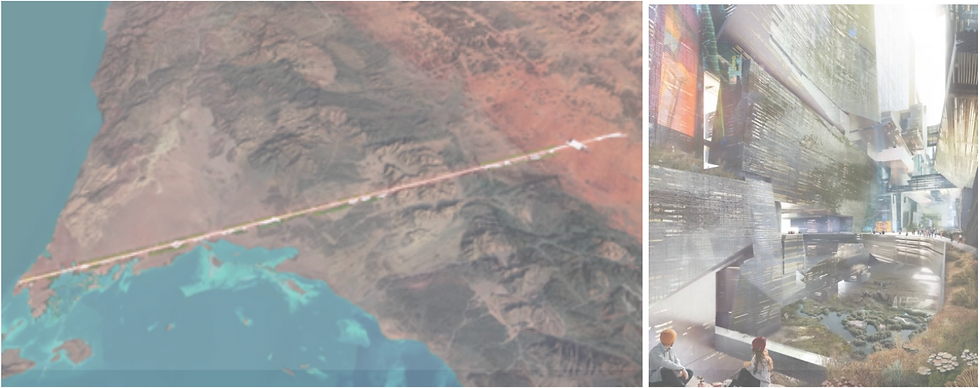The Line: Portal to the Future of Cities
- Tomás Woods
- Nov 28, 2023
- 4 min read

The Line artist’s interpretation The Line construction update October 2023
The Line is an 170km long city conceived and built by NEOM that cuts through the north of the Saudi Arabian desert and into the Red Sea. Earthworks began in late 2021 and it is well underway to have 40km of it completed by 2030. Many critics have shown resistance toward its concept while others have marveled at its architectural achievements. Here is all you need to know about the world’s first utopia and what exactly NEOM plans to achieve with it.
The Line is one of NEOM’s 4 megaprojects announced in 2017 and conceived to serve as the home for over 9 million people. The structure itself consists of two parallel buildings that are over 170km long, only 200m wide and 500 meters in height (or over 50 meters taller than the Empire State Building). The reason for Saudi Arabia’s next megacity being a line has to do with several factors that relate to thermal optimization, operations & logistics, environment preservation and arguably even solar exposure which will be discussed in detail through this article.
To begin with, thanks to its verticalized design, The Line will have the highest population density of any city, over 10 times denser than the island of Manhattan in New York for example. The concept of living in a verticalized city is also revolutionary and can be applied to other places in the world in order to help preserve the surrounding natural ecosystems. Notwithstanding, The Line in Saudi Arabia will also prove that it is possible to create communities where walking can replace fossil fuel powered transport networks or cars. In fact, the cities’ architects expect any practical destination in the everyday life of community residents to be no more than 5-minutes of walk away. This is emphasized by the fact that this is a 3-dimensional city and will offer a wider range of places in a lower footprint of space. In addition, the thermal advantages of verticalized line city are also a factor considered by architects especially in the context of its construction in the desert. This design makes it possible to contain cool air within the city’s walls while the center vain between the parallel buildings will serve as a chimney over which the hot air escapes. Moreover, the fact of having both walls placed so close to each other will also create shade and avoid the energy dense sunrays. In terms of its material choice for the façade, the reflective glass material to be used is of outstanding shielding capability, reflecting almost all of the infrared radiation away from the city.
Furthermore, the selected construction site for the city will lead us into understanding further design choices made by architects and how natural factors such as solar exposure and water sources are explored at upmost efficiency. Despite most of its structure being located in the desert, it is able to have access to water at its furthest left point in the Red Sea where distillation systems will be ready to filter the salt content from the water. Because the initial concept behind The Line is to make a self-sustaining city, this water is of evidential importance when it comes to supplying the population whether directly or indirectly. So, not only will the water go into people’s homes as it will also be used to irrigate the many vertical crops that feed the population with vegetarian nutrients as well as maintaining the vertical public gardens throughout. When it comes to solar orientation, The Line’s chosen location (parallel to the equator) accompanies the trajectory of the sun throughout the day which enables a fully illuminated interior.

The artist’s interpretation of the city of London transformed into another “The Line”.
As we explore The Line’s design choices and the future of urbanization, sustainability must be considered as one of the primary drives for innovation. During the planning process, architects had simplicity in mind and, knowing that the shortest distance between 2 points is a straight line, decided that such was also true when it came to transportation. The Line will be connected by a high-speed rail system that will run under the city with an end-to-end transit of only 20 minutes. While spread out cities like London and New York require complex networks of undergrounds, The Line will operate under the simplest possible transport system, eliminating time and energy consumption and a world of calculations.
Despite the magnitude of this project in both economic and political aspects, many architects and futurists have agreed that this could be the most effective way of dealing with modern-day urban problems. Be it in terms of thermal efficiency, local resource utilization, footprint, logistics or sustainability, The Line reinventing the future of urbanization and establishing new insight into a portal where innovation is just the tip of the iceberg.
Citations (in MLA Format):
“NEOM Saudi Arabia gives behind-the-scenes video update on The Line, Oxagon, Sindalah, Trojena, and more." Arabian Business, www.arabianbusiness.com/industries/construction/neom-saudi-arabia-gives-behind-the-scenes-video-update-on-the-line-oxagon-sindalah-trojena-and-more. Accessed 21 Nov. 2023.
"The Line: Imagens de satélite mostram como evolui a construção da megacidade na Arábia Saudita." SAPO Tek, tek.sapo.pt/multimedia/artigos/the-line-imagens-de-satelite-mostram-como-evolui-a-construcao-da-megacidade-na-arabia-saudita. Accessed 21 Nov. 2023."The Line: A 170 km Long Future City in Saudi Arabia's Desert." BeeSmart City, www.beesmart.city/en/strategy/the-line-a-170-km-long-future-city-in-saudi-arabias-desert#:~:text=Estimated%20building%20costs%20for%20The,to%20be%20completed%20in%202030. Accessed 21 Nov. 2023.
"Construction Begins on The Line, Saudi Arabia's City of the Future." Oak Park Talon, oakparktalon.org/16789/feature/construction-begins-on-the-line-saudi-arabias-city-of-the-future/#:~:text=While%20NEOM%20initially%20aimed%20for,since%20the%20beginning%20of%20construction. Accessed 21 Nov. 2023.
"The Line - NEOM." NEOM, www.neom.com/en-us/regions/theline. Accessed 21 Nov. 2023.






Comments